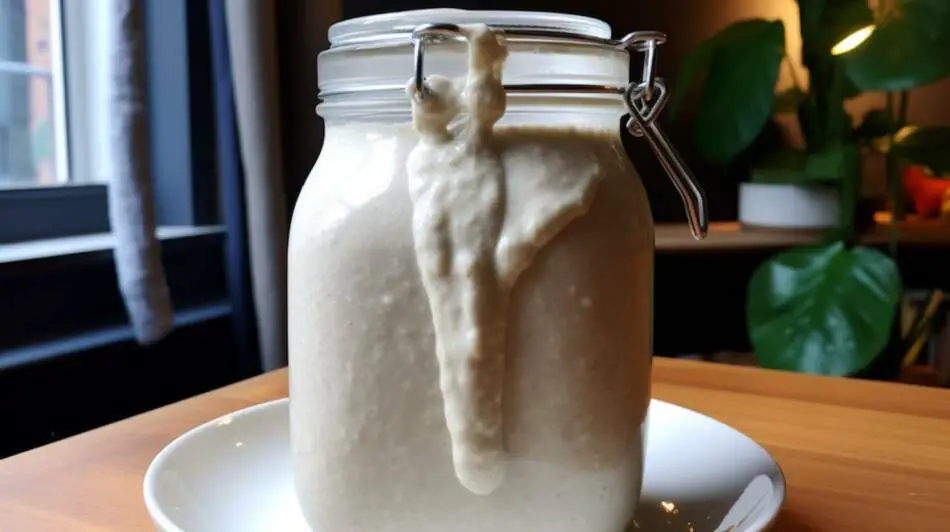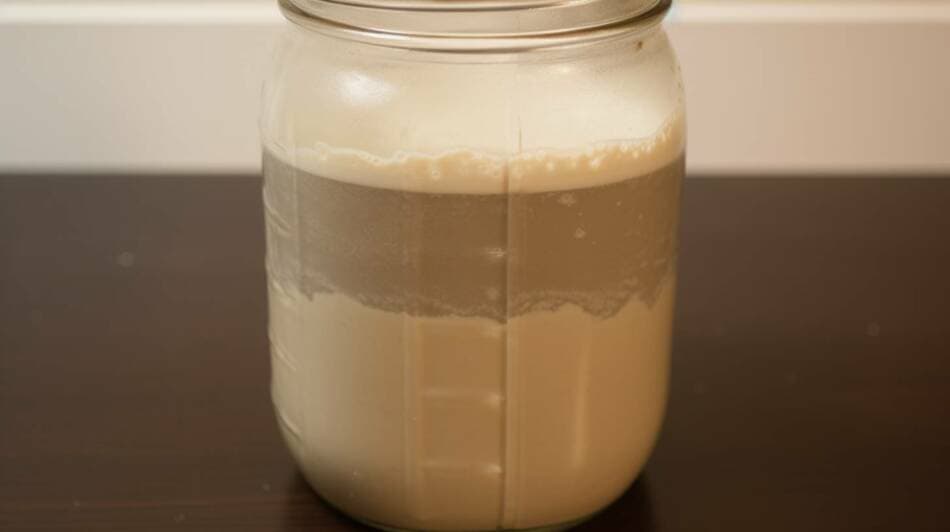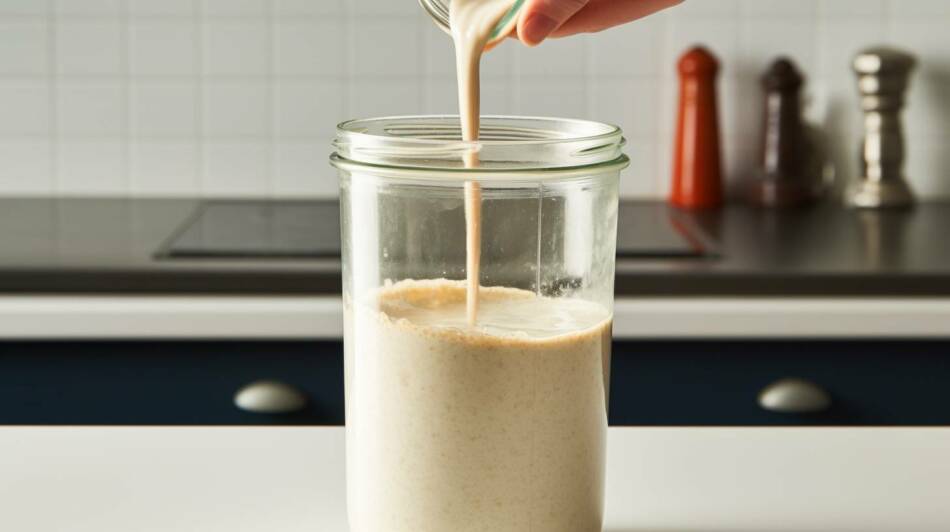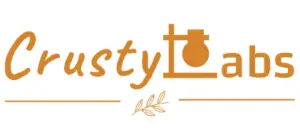Sourdough starters are a blend of flour, water, and the naturally occurring bacteria and yeast found in the environment. They can be somewhat finicky and present some challenges, especially for new bakers. This article delves into common issues faced by sourdough enthusiasts, ways to diagnose them, and solutions to ensure a vibrant and healthy starter.
- 1. Why is my sourdough starter not doubling in size?
- 2. Why does my new sourdough starter seem less active compared to the first few days?
- 3. Why does sourdough starter rise and then fall after feeding?
- 4. My Sourdough Starter Failed the Float Test – Now What?
- 5. Why are my sourdough bubbles so small?
- 6. Why Did My Sourdough Starter Overflow its Jar?
- 7. I ran out of flour, can I use a different flour to feed my sourdough starter?
- 8. What happens if I forget to feed my sourdough starter?
- 9. There is a clear liquid layer on top (Hooch) of my sourdough starter
- 10. Why does my Sourdough Starter have an Obtrusive Alcoholic/Acetone Smell?
- 11. Why does my Sourdough Starter smell very Acidic?
- 12. Why does my Sourdough Starter smell Putrid like Old Socks?
- 13. Mold: What is the fuzzy growth on top of my sourdough starter?
- 14. Why is my sourdough starter so thick and dense?
- 15. Why is my sourdough starter so thin and watery?
- 16. Crust on Sourdough Starter: Causes and Fixes
- 17. Preventing Fruit Flies from Targeting Sourdough Starter
- Conclusion:
1. Why is my sourdough starter not doubling in size?
Diagnosis:
A hallmark of a healthy sourdough starter is its ability to rise after being fed. This rise indicates active fermentation and the presence of lively yeast and bacteria. If the starter isn’t doubling or at least showing significant growth within 4-8 hours after feeding, it may be due to several factors.
The starter could be underfed, meaning it has exhausted its food supply. It might be lacking in vitality because of prolonged neglect. Lastly, environmental factors like temperature can play a role; a cold environment can slow down microbial activity.
Solution:
It’s crucial to provide an optimal environment for your starter. Keeping your starter at a warm room temperature, between 78°F (25°C) to 82°F (28°C), can encourage more rapid and vigorous growth.
Regular feedings of at least once a day, ensure that the microbial population always has a fresh food supply. Sticking to a 1:1:1 ratio by weight for starter, water, and flour can be beneficial.
If you find your starter perpetually sluggish, incorporating rye or whole wheat flour can invigorate it. These flours are often richer in minerals, enzymes, and nutrients that wild yeast and bacteria love.
2. Why does my new sourdough starter seem less active compared to the first few days?

Diagnosis:
During the initial days of creating a sourdough starter from scratch, it’s not uncommon to see a burst of activity, followed by a lull. This initial activity often results from different types of bacteria and yeast that might not be the stable, long-term residents of a mature starter. As the environment becomes more acidic and the starter establishes its pH, some of these initial microbes die off or decrease in population, leading to reduced visible activity.
Solution:
Patience is key. Continue with your regular feeding schedule, discarding and replenishing with fresh flour and water. Over time, the beneficial strains of yeast and lactic acid bacteria will colonize and stabilize in the starter, leading to consistent bubbling and rising. Make sure to maintain a warm environment and consider occasionally introducing whole grain flours to provide a broader spectrum of nutrients.
3. Why does sourdough starter rise and then fall after feeding?
Diagnosis:
A starter that rises and then falls has typically reached its peak activity and exhausted its food supply. The rise is due to the production of carbon dioxide by the yeast during fermentation. Once the food (starches and sugars from the flour) is consumed, the yeast’s activity slows, and the trapped carbon dioxide escapes, leading the starter to fall or collapse.
Solution:
This is a normal part of the fermentation process. However, if you notice this pattern regularly, it might be an indicator that your starter is ready to be fed more frequently or in larger amounts. If your starter consistently peaks and falls within a few hours of feeding, consider feeding it more often or increasing the feeding ratio to give it more flour and water. Observing when your starter reaches its peak can also help you determine the optimal time to use it in recipes for the best rise and flavor.
4. My Sourdough Starter Failed the Float Test – Now What?
Diagnosis:
The “float test” is a popular method to check if a sourdough starter is ready for baking. You drop a small spoonful of your starter into a glass of water, and if it floats, it’s ready. However, not floating doesn’t necessarily mean your starter is unhealthy. Several factors could contribute to this result. For instance, the starter might be overripe, or it could simply be too dense.
Solution:
Don’t rely solely on the float test. Instead, observe other signs of a healthy starter. Is it doubling in volume within 4-8 hours of feeding? Does it have a pleasant, tangy aroma? Does it have a good balance of bubbles? If your starter is showing these signs, it’s likely active and ready for baking, regardless of the float test.
If you’re repeatedly failing the float test but seeing other positive signs, consider increasing hydration (adding more water) during feedings, which can make the starter less dense and more likely to float.
5. Why are my sourdough bubbles so small?
Diagnosis:
A healthy starter will have a combination of large and small bubbles, indicating active fermentation. However, if your starter consistently lacks those coveted big bubbles, it might be too watery, or the fermentation might not be vigorous enough.
Solution:
- Adjust the hydration. A slightly drier starter can help facilitate the development of larger bubbles.
- Consider the flour you’re using. Whole grain flours, such as whole wheat or rye, often produce a starter with more significant bubbles due to the increased nutrients and enzymes they provide.
- Ensure that your starter is kept in an optimal temperature range of around 78°F (25°C) to 82°F (28°C). A warmer environment can boost fermentation activity and bubble production.
- Stir your starter less frequently. Letting it sit undisturbed can sometimes allow bigger bubbles to form.
6. Why Did My Sourdough Starter Overflow its Jar?

Diagnosis:
An overflowing starter indicates vigorous fermentation. The yeast and bacteria in the starter produce gas as they ferment the flour’s sugars and starches. This expansion can be due to highly active microbes, warm temperatures, or a too-small container.
Solution:
- Switch to a larger container: Give your starter more room to grow to avoid spillage.
- Maintain optimal temperature: Warm environments speed up fermentation. Aim for a range of 78°F (25°C) to 82°F (28°C) to manage the starter’s growth rate.
- Increase feeding ratio to 1:2:2 or 1:3:3 : Reduce the initial amount of starter before feeding to manage its volume.
- Stir occasionally: If your starter is nearing the container’s top, a gentle stir can release gas and prevent overflow.
7. I ran out of flour, can I use a different flour to feed my sourdough starter?
Diagnosis:
Maintaining a consistent flour type can lead to a stable microbial population in your starter. However, emergencies arise, and sometimes you might run out of your usual flour. Different flours have varying mineral contents, protein levels, and types of carbohydrates, which can affect the starter’s fermentation.
Solution:
In short, yes, you can feed your starter with a different type of flour. However, there are some guidelines to consider:
- Gradually introduce the new flour. Instead of a sudden switch, try a mix of your usual flour (if you have some left) and the new one, gradually increasing the proportion of the new flour over several feedings.
- Be observant. Different flours can change the behavior, aroma, and appearance of your starter. For instance, rye and whole wheat flours can accelerate fermentation and produce a more vigorous starter, while all-purpose flour might make your starter less bubbly.
- Always return to your preferred flour when it’s available. This will bring your starter back to its familiar state. But remember, occasional flour changes can actually enhance the resilience and biodiversity of your sourdough culture.
8. What happens if I forget to feed my sourdough starter?
Diagnosis:
Sourdough starters are resilient, but they rely on regular feedings to maintain their vitality and health. If you forget to feed your starter, over time it can become sluggish, less active, and develop a more pronounced acidic aroma. The pH might become too low, making the environment too acidic, which can weaken the yeast and hinder its growth.
Solution:
If you’ve forgotten a feeding or two, don’t panic. Start by discarding half of your starter and then feeding it with fresh flour and water, following your usual ratios. You might need to feed it a few times before you see it return to its regular activity.
If your starter has been neglected for an extended period, say weeks, you might notice a buildup of hooch. Discard this liquid, give your starter a good feed, and be patient. With consistent feedings, most starters bounce back. However, if after multiple feedings you don’t notice any improvement, you might need to start a new culture.
9. There is a clear liquid layer on top (Hooch) of my sourdough starter

Diagnosis:
Hooch is an alcohol-rich liquid that forms when the yeast and bacteria in your starter have consumed most of the available nutrients from the flour and are essentially “starving.” This liquid can range from a clear to a dark tea color and indicates that your starter is quite hungry.
Solution:
The formation of hooch indicates that your starter needs to be fed more often or in greater quantities. Start by pouring off the hooch, but if you forget, it’s not the end of the world; stirring it back in will just make your starter a bit more sour. Feed your starter using your regular ratios.
If you consistently observe the formation of hooch, consider adjusting your feeding schedule. For instance, if you feed your starter once daily, you might need to switch to twice daily. Alternatively, if your starter is at room temperature, consider moving it to a cooler spot to slow down its fermentation or increasing the amount of flour and water during feedings.
10. Why does my Sourdough Starter have an Obtrusive Alcoholic/Acetone Smell?
Diagnosis:
A pronounced alcoholic or acetone-like smell (similar to nail polish remover) in your sourdough starter is an indication that the yeast and bacteria are producing higher amounts of ethanol as a byproduct of fermentation. This usually signals that the starter is running out of food (flour) and is becoming too acidic.
Factors contributing to this smell include:
- Extended time between feedings: The yeast and bacteria have consumed most of the available food.
- Warmer temperatures: Higher temperatures can accelerate fermentation, causing the starter to exhaust its food supply more quickly.
Solution:
- Regular feeding: Ensure you feed your starter more frequently, especially if kept at room temperature. This provides fresh food, reducing the chances of it developing the acetone smell.
- Refrigeration: If you’re not baking every day, you can keep your starter in the refrigerator, which slows down the fermentation process. Remember to let it come to room temperature and feed it at least once before using it in a recipe.
- Change feeding ratios: If your starter is maturing too quickly, consider feeding it with a higher ratio of flour and water to the amount of starter.
11. Why does my Sourdough Starter smell very Acidic?
Diagnosis:
A pronounced acidic smell, reminiscent of vinegar, indicates the production of acetic acid by the bacteria present in the starter. While a mildly tangy smell is normal for a sourdough starter, a very sharp acidic odor can indicate an imbalance.
Factors contributing to this smell:
- Prolonged fermentation: Allowing the starter to sit too long between feedings can lead to increased acid production.
- Lower temperatures: Cooler temperatures favor bacteria that produce more acetic acid compared to lactic acid.
Solution:
- Increase feeding frequency: Feed your starter more frequently to prevent excessive acid build-up.
- Increase the feeding ratio: Decrease the amount of existing starter when feeding, which dilutes the acidity.
- Optimize temperature: If your starter is kept in a cooler place, try moving it to a slightly warmer location.
12. Why does my Sourdough Starter smell Putrid like Old Socks?
Diagnosis:
A starter that emits a foul, off-putting smell reminiscent of old socks or rotten food is likely contaminated. A healthy sourdough starter should never have a putrid smell.
Factors contributing to this smell:
- Contamination: Introduction of unwanted microbes from unclean utensils, jars, or even the air.
- Infrequent feedings: Neglecting your starter can make it more susceptible to harmful microbes.
Solution:
- Start afresh: If your starter smells putrid, it’s safest to discard it and begin anew. Using it could result in off-flavors in your bread and could even be harmful.
- Maintain cleanliness: Always use clean utensils and jars. Wash your hands before handling your starter.
- Establish a consistent feeding routine: A regularly fed starter is healthier and less prone to contamination.
13. Mold: What is the fuzzy growth on top of my sourdough starter?

Diagnosis:
Mold, a type of fungus, can present itself as fuzzy patches, odd colors (like pink, blue, green, or black), or even a distinctly moldy smell. Unlike the normal fermentation process where good bacteria and yeast are at work, mold is an unwanted guest in your sourdough starter and signals contamination.
Solution:
Unfortunately, when mold forms on your sourdough starter, the best course of action is to discard it. Mold spores can penetrate deeper than the visible surface, so simply scraping off the moldy portion isn’t a guarantee of safety.
To prevent mold growth in the future:
- Ensure all utensils, jars, and tools are thoroughly cleaned before using.
- Wash your hands properly before handling your starter.
- Cover your starter container with a breathable yet tight-weave cloth or a lid to prevent airborne contaminants while allowing gases to escape.
- Store your starter in a cool and clean place, and avoid cross-contamination with other fermenting foods.
14. Why is my sourdough starter so thick and dense?
Diagnosis:
A starter that’s too thick can struggle to rise properly, as the dense consistency may inhibit the growth of yeast and bacteria. This texture issue can stem from multiple causes, including using a flour type with higher water absorption or inaccurately measuring ingredients.
Solution:
- Increase the hydration. Try feeding your starter with a slightly increased water-to-flour ratio. For instance, if you’ve been using a 1:1 ratio, consider switching to a 1:1.25 (starter:water) ratio to introduce more moisture.
- Double-check measurement methods. Measure by weight using a digital scale can provide more consistent and accurate results compared to volume measurements like cups.
- Remember, the type of flour matters. Whole grain flours can absorb more water than white flours. When using whole grain flours, increase the amount of water when feeding the starter.
15. Why is my sourdough starter so thin and watery?

Diagnosis:
A watery starter might not hold gases well, leading to less rise and a weaker structure. Overhydration, or too much water in the mixture, is often the culprit, but sometimes fermentation can also produce excess liquid.
Solution:
- Gradually increase the amount of flour you use during feedings until you reach the desired consistency.
- Consider the type of flour you’re using. Some flours, like all-purpose flour, might create a runnier starter compared to whole grain flours.
- Ensure consistent measurements. Again, measuring by weight using a digital scale can be invaluable in ensuring you’re adding consistent amounts of flour and water.
- Observe the starter after feedings. If it continues to separate or become watery quickly after feeding, this could indicate that it’s being fed too infrequently or is kept in a location that’s too warm, accelerating fermentation and causing it to exhaust its food supply rapidly. In that case, increase feeding frequency and ratio, and store the starter in a cooler area.
16. Crust on Sourdough Starter: Causes and Fixes
Diagnosis:
Crust formation signals excessive moisture loss due to factors like improper sealing, dry environments, or infrequent feedings.
Solution:
- Discard the crusty layer.
- Store in airtight containers.
- If unavailable, use plastic wrap or a damp cloth as a lid.
- Regularly feed and stir the starter.
- Increase room humidity if in a dry area.
17. Preventing Fruit Flies from Targeting Sourdough Starter
Diagnosis:
Solution:
- Utilize airtight containers for storage.
- Alternatively, cover with a fine mesh or cloth.
- Keep the surrounding area clean and fruit-free.
- Use a fly trap.
- If all else fails, refrigerate the starter.
Conclusion:
Maintaining a sourdough starter is both an art and a science. While there might be a learning curve, understanding the common problems and their solutions can make the journey smoother. Always remember that with patience, observation, and regular feeding, you can foster a robust and resilient sourdough starter that serves as the foundation for countless delicious breads and baked goods.


